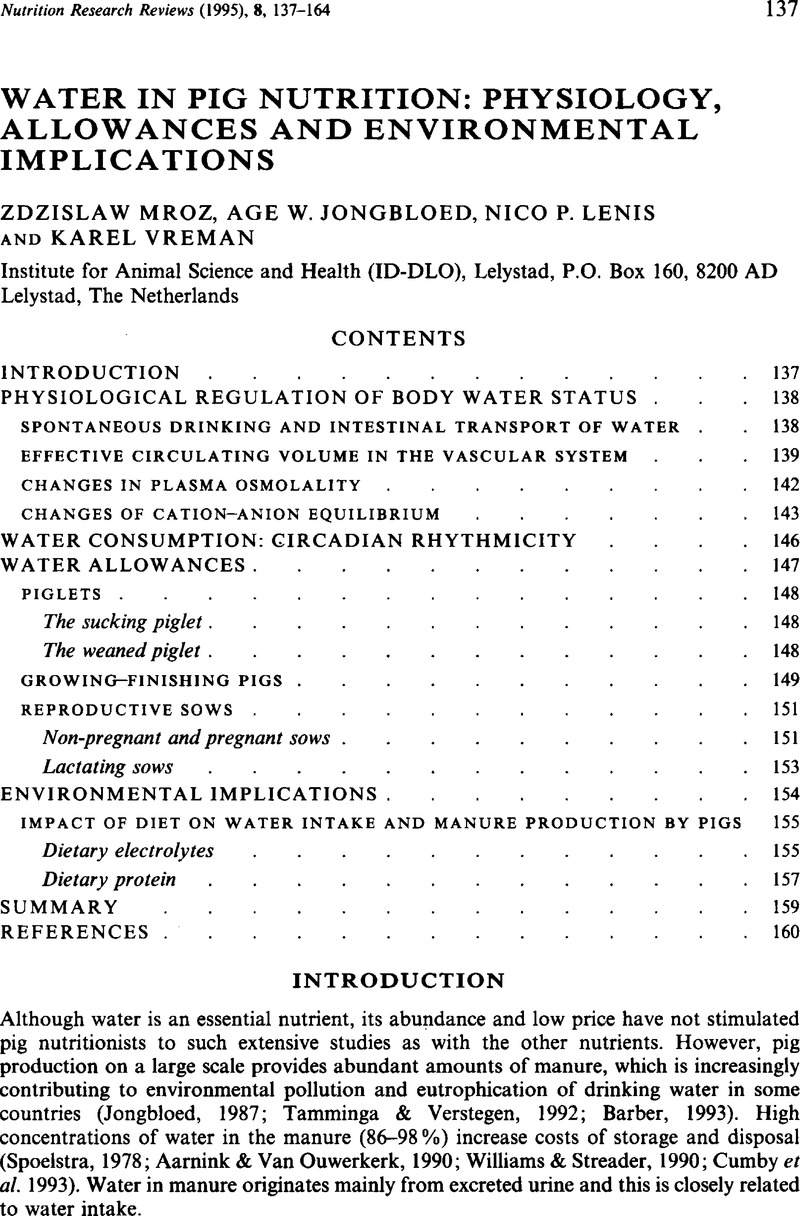Crossref Citations
This article has been cited by the following publications. This list is generated based on data provided by Crossref.
Jongbloed, A. W.
Lenis, N. P.
and
Mroz, Z.
1997.
Impact of nutrition on reduction of environmental pollution by pigs: An overview of recent research.
Veterinary Quarterly,
Vol. 19,
Issue. 3,
p.
130.
Stookey, J.D.
1999.
Another look at: fuel + O2→ CO2+ H2O. Developing a water-oriented perspective.
Medical Hypotheses,
Vol. 52,
Issue. 4,
p.
285.
Thacker, Philip
2000.
Swine Nutrition, Second Edition.
Oenema, Oene
Bannink, André
Sommer, Sven G.
and
Velthof, Gerard L.
2001.
Nitrogen in the Environment: Sources, Problems and Management.
p.
255.
Deligeorgis, Stelios G.
Karalis, Kostas
and
Kanzouros, Georgios
2006.
The influence of drinker location and colour on drinking behaviour and water intake of newborn pigs under hot environments.
Applied Animal Behaviour Science,
Vol. 96,
Issue. 3-4,
p.
233.
Shaw, M. I.
Beaulieu, A. D.
and
Patience, J. F.
2006.
Effect of diet composition on water consumption in growing pigs1.
Journal of Animal Science,
Vol. 84,
Issue. 11,
p.
3123.
Groenestein, C.M.
Monteny, G.J.
Aarnink, A.J.A.
and
Metz, J.H.M.
2007.
Effect of urinations on the ammonia emission from group-housing systems for sows with straw bedding: Model assessment.
Biosystems Engineering,
Vol. 97,
Issue. 1,
p.
89.
Oenema, O.
Bannink, A.
Sommer, S.G.
Van Groenigen, J.W.
and
Velthof, G.L.
2008.
Nitrogen in the Environment.
p.
395.
Vermeer, Herman M.
Kuijken, Nienke
and
Spoolder, Hans A.M.
2009.
Motivation for additional water use of growing-finishing pigs.
Livestock Science,
Vol. 124,
Issue. 1-3,
p.
112.
Oliviero, Claudio
Kokkonen, Teija
Heinonen, Mari
Sankari, Satu
and
Peltoniemi, Olli
2009.
Feeding sows with high fibre diet around farrowing and early lactation: Impact on intestinal activity, energy balance related parameters and litter performance.
Research in Veterinary Science,
Vol. 86,
Issue. 2,
p.
314.
Schiavon, Stefano
Dal Maso, Matteo
Cattani, Mirko
and
Tagliapietra, Franco
2009.
A simplified approach to calculate slurry production of growing pigs at farm level.
Italian Journal of Animal Science,
Vol. 8,
Issue. 3,
p.
431.
Bøe, K. E.
and
Kjelvik, O.
2011.
Water nipples or water bowls for weaned piglets: Effect on water intake, performance, and plasma osmolality.
Acta Agriculturae Scandinavica, Section A - Animal Science,
Vol. 61,
Issue. 2,
p.
86.
Patience, John F.
2012.
The importance of water in pork production.
Animal Frontiers,
Vol. 2,
Issue. 2,
p.
28.
Mason, Sharon E.
Almond, Glen W.
Riviere, Jim E.
and
Baynes, Ronald E.
2012.
Evaluation of factors important in modeling plasma concentrations of tetracycline hydrochloride administered in water in swine.
American Journal of Veterinary Research,
Vol. 73,
Issue. 10,
p.
1641.
Alvarez-Rodriguez, J.
Hermida, B.
Parera, J.
Morazán, H.
Balcells, J.
and
Babot, D.
2013.
The influence of drinker device on water use and fertiliser value of slurry from growing-finishing pigs.
Animal Production Science,
Vol. 53,
Issue. 4,
p.
328.
Patience, John F.
2013.
Sustainable Swine Nutrition.
p.
1.
Nannoni, E.
Martelli, G.
Cecchini, M.
Vignola, G.
Giammarco, M.
Zaghini, G.
and
Sardi, L.
2013.
Water requirements of liquid-fed heavy pigs: Effect of water restriction on growth traits, animal welfare and meat and ham quality.
Livestock Science,
Vol. 151,
Issue. 1,
p.
21.
Andersen, Heidi Mai-Lis
and
Pedersen, Lene Juul
2014.
Drinking behaviour in sows kept outdoors during the winter months.
Applied Animal Behaviour Science,
Vol. 161,
Issue. ,
p.
34.
Tavares, J.M.R.
Filho, P. Belli
Coldebella, A.
and
Oliveira, P.A.V.
2014.
The water disappearance and manure production at commercial growing-finishing pig farms.
Livestock Science,
Vol. 169,
Issue. ,
p.
146.
Andersen, H.M.-L.
Dybkjær, L.
and
Herskin, M.S.
2014.
Growing pigs’ drinking behaviour: number of visits, duration, water intake and diurnal variation.
Animal,
Vol. 8,
Issue. 11,
p.
1881.



